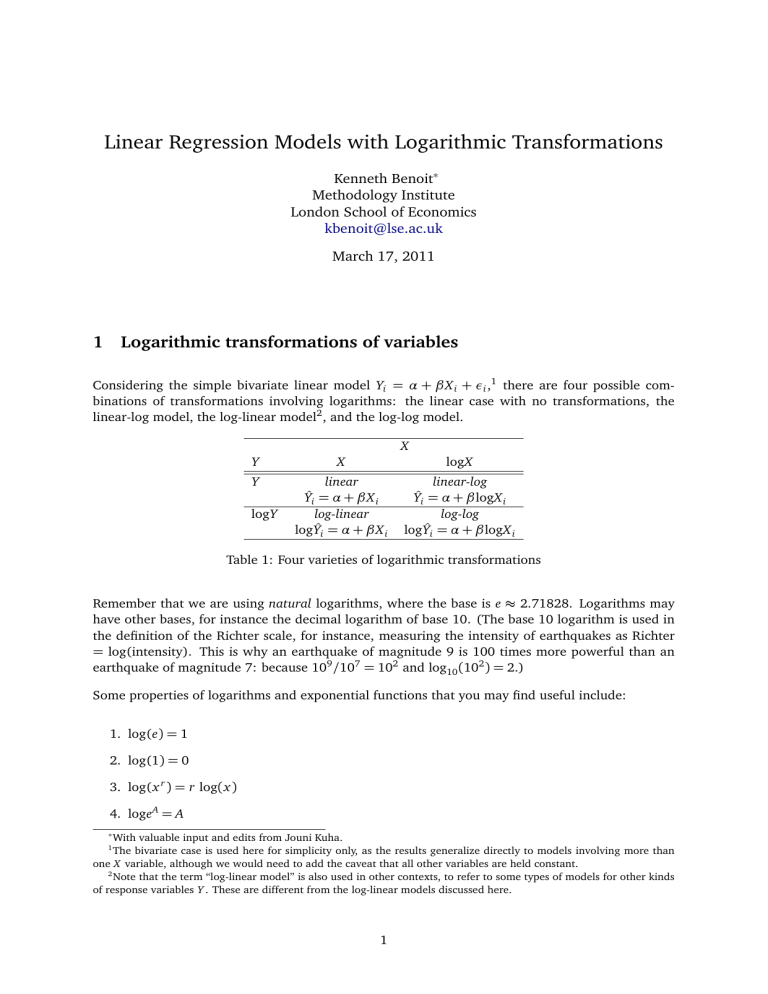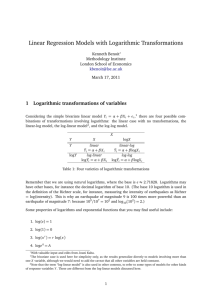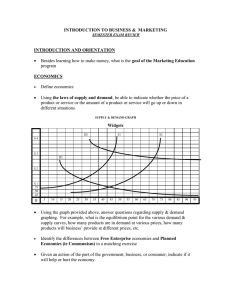
Linear Regression Models with Logarithmic Transformations Kenneth Benoit∗ Methodology Institute London School of Economics kbenoit@lse.ac.uk March 17, 2011 1 Logarithmic transformations of variables Considering the simple bivariate linear model Yi = α + β X i + εi ,1 there are four possible combinations of transformations involving logarithms: the linear case with no transformations, the linear-log model, the log-linear model2 , and the log-log model. X Y X logX Y linear Ŷi = α + β X i log-linear logŶi = α + β X i linear-log Ŷi = α + βlogX i log-log logŶi = α + βlogX i logY Table 1: Four varieties of logarithmic transformations Remember that we are using natural logarithms, where the base is e ≈ 2.71828. Logarithms may have other bases, for instance the decimal logarithm of base 10. (The base 10 logarithm is used in the definition of the Richter scale, for instance, measuring the intensity of earthquakes as Richter = log(intensity). This is why an earthquake of magnitude 9 is 100 times more powerful than an earthquake of magnitude 7: because 109 /107 = 102 and log10 (102 ) = 2.) Some properties of logarithms and exponential functions that you may find useful include: 1. log(e) = 1 2. log(1) = 0 3. log(x r ) = r log(x) 4. logeA = A ∗ With valuable input and edits from Jouni Kuha. The bivariate case is used here for simplicity only, as the results generalize directly to models involving more than one X variable, although we would need to add the caveat that all other variables are held constant. 2 Note that the term “log-linear model” is also used in other contexts, to refer to some types of models for other kinds of response variables Y . These are different from the log-linear models discussed here. 1 1 5. elogA = A 6. log(AB) = logA + logB 7. log(A/B) = logA − logB B 8. eAB = eA 9. eA+B = eA e B 10. eA−B = eA/e B 2 Why use logarithmic transformations of variables Logarithmically transforming variables in a regression model is a very common way to handle situations where a non-linear relationship exists between the independent and dependent variables.3 Using the logarithm of one or more variables instead of the un-logged form makes the effective relationship non-linear, while still preserving the linear model. Logarithmic transformations are also a convenient means of transforming a highly skewed variable into one that is more approximately normal. (In fact, there is a distribution called the log-normal distribution defined as a distribution whose logarithm is normally distributed – but whose untransformed scale is skewed.) 0 200 400 600 For instance, if we plot the histogram of expenses (from the MI452 course pack example), we see a significant right skew in this data, meaning the mass of cases are bunched at lower values: 0 500 1000 1500 2000 2500 3000 Expenses If we plot the histogram of the logarithm of expenses, however, we see a distribution that looks much more like a normal distribution: 3 The other transformation we have learned is the quadratic form involving adding the term X 2 to the model. This produces curvature that unlike the logarithmic transformation that can reverse the direction of the relationship, something that the logarithmic transformation cannot do. The logarithmic transformation is what as known as a monotone transformation: it preserves the ordering between x and f (x). 2 100 80 60 40 20 0 2 4 6 8 Log(Expenses) 3 3.1 Interpreting coefficients in logarithmically models with logarithmic transformations Linear model: Yi = α + β X i + εi Recall that in the linear regression model, logYi = α + β X i + εi , the coefficient β gives us directly the change in Y for a one-unit change in X . No additional interpretation is required beyond the estimate β̂ of the coefficient itself. This literal interpretation will still hold when variables have been logarithmically transformed, but it usually makes sense to interpret the changes not in log-units but rather in percentage changes. Each logarithmically transformed model is discussed in turn below. 3.2 Linear-log model: Yi = α + βlogX i + εi In the linear-log model, the literal interpretation of the estimated coefficient β̂ is that a one-unit increase in logX will produce an expected increase in Y of β̂ units. To see what this means in terms of changes in X , we can use the result that log X + 1 = log X + log e = log(eX ) which is obtained using properties 1 and 6 of logarithms and exponential functions listed on page 1. In other words, adding 1 to log X means multiplying X itself by e ≈ 2.72. A proportional change like this can be converted to a percentage change by subtracting 1 and multiplying by 100. So another way of stating “multiplying X by 2.72” is to say that X increases by 172% (since 100 × (2.72 − 1) = 172). So in terms of a change in X (unlogged): 3 • β̂ is the expected change in Y when X is multiplied by e. • β̂ is the expected change in Y when X increases by 172% • For other percentage changes in X we can use the following result: The expected change in Y associated with a p% increase in X can be calculated as β̂ · log([100 + p]/100). So to work out the expected change associated with a 10% increase in X , therefore, multiply β̂ by log(110/100) = log(1.1) = .095. In other words, 0.095β̂ is the expected change in Y when X is multiplied by 1.1, i.e. increases by 10%. • For small p, approximately log([100 + p]/100) ≈ p/100. For p = 1, this means that β̂/100 can be interpreted approximately as the expected increase in Y from a 1% increase in X 3.3 Log-linear model: logYi = α + β X i + εi In the log-linear model, the literal interpretation of the estimated coefficient β̂ is that a one-unit increase in X will produce an expected increase in log Y of β̂ units. In terms of Y itself, this means that the expected value of Y is multiplied by eβ̂ . So in terms of effects of changes in X on Y (unlogged): • Each 1-unit increase in X multiplies the expected value of Y by eβ̂ . • To compute the effects on Y of another change in X than an increase of one unit, call this change c, we need to include c in the exponent. The effect of a c-unit increase in X is to multiply the expected value of Y by e c β̂ . So the effect for a 5-unit increase in X would be e5β̂ . • For small values of β̂, approximately eβ̂ ≈ 1+ β̂. We can use this for the following approximation for a quick interpretation of the coefficients: 100 · β̂ is the expected percentage change in Y for a unit increase in X . For instance for β̂ = .06, e.06 ≈ 1.06, so a 1-unit change in X corresponds to (approximately) an expected increase in Y of 6%. 3.4 Log-log model: logYi = α + βlogX i + εi In instances where both the dependent variable and independent variable(s) are log-transformed variables, the interpretation is a combination of the linear-log and log-linear cases above. In other words, the interpretation is given as an expected percentage change in Y when X increases by some percentage. Such relationships, where both Y and X are log-transformed, are commonly referred to as elastic in econometrics, and the coefficient of log X is referred to as an elasticity. So in terms of effects of changes in X on Y (both unlogged): • multiplying X by e will multiply expected value of Y by eβ̂ • To get the proportional change in Y associated with a p percent increase in X , calculate a = log([100 + p]/100) and take e aβ̂ 4 ome ome examples examples ! Examples Let's consider the Let'sLinear-log. consider the relationship relationship between between the the percentage percentage Consider the regression of % urban population (1995) on per capita GNP: urban urban and and per per capita capita GNP: GNP: % urban 95 (World Bank) % urban 95 (World Bank) 100 100 88 77 77 UnitedNations Nationsper percapita capitaGDP GDP United 42416 42416 distribution of per capita GDP is badly skewed, creating a non-linear relationship between X ThisThe doesn't look too good. Let's try transforming transforming the per This doesn't good. try the and Y . To controllook the skew too and counter problems Let's in heteroskedasticity, we transform GNP/capita by taking its logarithm. This produces the following plot: capita GNP GNP by by logging logging it: it: capita 100 100 % urban 95 (World Bank) % urban 95 (World Bank) ! 4 88 4.34381 4.34381 lPcGDP95 lPcGDP95 and the regression with the following results: 5 10.6553 10.6553 ! That looked pretty good. Now let's quantify the association between percentage urban and the logged per capita income: . regress urb95 lPcGDP95 Source | SS df MS Number of obs = 132 ---------+-----------------------------F( 1, 130) = 158.73 Model | 38856.2103 1 38856.2103 Prob > F = 0.0000 Residual | 31822.7215 130 244.790165 R-squared = 0.5498 ---------+-----------------------------Adj R-squared = 0.5463 Total | 70678.9318 131 539.533831 Root MSE = 15.646 -----------------------------------------------------------------------------urb95 | Coef. Std. Err. t P>|t| [95% Conf. Interval] ---------+-------------------------------------------------------------------lPcGDP95 | 10.43004 .8278521 12.599 0.000 8.792235 12.06785 _cons | -24.42095 6.295892 -3.879 0.000 -36.87662 -11.96528 ------------------------------------------------------------------------------ ! The implication of this coefficient is that multiplying To interpret the coefficient of 10.43004 on the log of the GNP/capita variable, we can make the capita income by e, roughly 2.71828, 'increases' the following statements: percentage urban by 10.43 percentage points. Increasing per capita income by 10% 'increases' the Directly from the coefficient: An increase of 1 in the log of GNP/capita will increase Y by 10.43004. percentage urban by 10.43*0.09531 = 0.994 percentage (This is not extremely interesting, however, since few people are sure how to interpret the points. natural logarithms of GDP/capita.) ! Multiplicative changes in e: Multiplying GNP/cap by e will increase Y by 10.43004. What about the situation where dependent variable is A 1% increase in X : A 1% increase in GNP/cap the will increase Y by 10.43004/100 = .1043 increase in X : A 10% increase in GNP/cap will increase Y by 10.43004 ∗ log(1.10) = ogged? A 10%10.43004 ∗ .09531 ≈ 0.994. Log-linear. What if we reverse X and Y from the above example, so that we regress the log of the %urban? In this case, the logarithmically transformed variable Y variable. on We GNP/capita couldonjust as easily have considered theis the 'effect' This leads to the following plot (which is just the transpose of the previous one — this is only an example!): logged per capita income of increasing urbanization: 10.6553 lPcGDP95 ! 4.34381 8 % urban 95 (World Bank) 100 with the following regression results: regress lPcGDP95 urb95 Source | SS df MS Number of obs = 13 --------+-----------------------------F( 1, 130) = 158.7 Model | 196.362646 1 196.362646 Prob > F = 0.000 esidual | 160.818406 130 1.23706466 R-squared = 0.549 6 --------+-----------------------------Adj R-squared = 0.546 Total | 357.181052 131 2.72657291 Root MSE = 1.112 ---------------------------------------------------------------------------- 4.34381 8 100 % urban 95 (World Bank) . regress lPcGDP95 urb95 Source | SS df MS Number of obs = 132 ---------+-----------------------------F( 1, 130) = 158.73 Model | 196.362646 1 196.362646 Prob > F = 0.0000 Residual | 160.818406 130 1.23706466 R-squared = 0.5498 ---------+-----------------------------Adj R-squared = 0.5463 Total | 357.181052 131 2.72657291 Root MSE = 1.1122 -----------------------------------------------------------------------------lPcGDP95 | Coef. Std. Err. t P>|t| [95% Conf. Interval] ---------+-------------------------------------------------------------------urb95 | .052709 .0041836 12.599 0.000 .0444322 .0609857 _cons | 4.630287 .2420303 19.131 0.000 4.151459 5.109115 ------------------------------------------------------------------------------ ! Every one point increase in the percentage urban multiplies 0.052709 To interpret the coefficient of income .052709 by on ethe urb95 variable, canwords, make the per capita = 1.054. In we other it following statements: increases per capita income by 5.4%. Directly from the coefficient, transformed Y : Each one unit increase urb95 in increases lPcGDP95 by .052709. (Once again, this is not particularly useful as we still have trouble thinking in terms of the natural logarithm of GDP/capita.) Directly from the coefficient, untransformed Y : Each one unit increase of urb95 increases the untransformed GDP/capita by a multiple of e0.52709 = 1.054 – or a 5.4% increase. (This is very close to the 5.3% increase that we get using our quick approximate rule described above for interpreting the .053 as yielding a 5.3% increase for a one-unit change in X .) ogged independent and dependent variables Here we consider a regression of the logarithm of the infant mortality rate on the log of Let'sLog-log. look at infant mortality and per capita income: GDP/capita. The plot and the regression results look like this: 5.1299 Logged independent and dependent variables ! Let's look at infant mortality and per capita income: lIMR 5.1299 lIMR ! 1.38629 3.58352 1.38629 3.58352 lPcGDP95 lPcGDP95 10.6553 10.6553 . regress lIMR lPcGDP95 Source | SS df MS Number of obs = 194 ---------+-----------------------------F( 1, 192) = 404.52 Model | 131.035233 1 131.035233 Prob > F = 0.0000 Residual | 62.1945021 192 .323929698 R-squared = 0.6781 ---------+-----------------------------Adj R-squared = 0.6765 Total | 193.229735 193 1.00119034 Root MSE = .56915 -----------------------------------------------------------------------------lIMR | Coef. Std. Err. t P>|t| [95% Conf. Interval] ---------+-------------------------------------------------------------------lPcGDP95 | -.4984531 .0247831 -20.113 0.000 -.5473352 -.449571 _cons | 7.088676 .1908519 37.142 0.000 6.71224 7.465111 ------------------------------------------------------------------------------ regress lIMR lPcGDP95 Source | SS df MS Number of obs = 1 --------+-----------------------------F( 1, 192) = 404. Model | 131.035233 1 131.035233 Prob > F = 0.00 esidual | 62.1945021 192 .323929698 R-squared = 0.67 --------+-----------------------------Adj R-squared = 0.67 Total | 193.229735 193 1.00119034 Root MSE = .569 --------------------------------------------------------------------------! coefficient Thus multiplying peron capita income byvariable, 2.718 multiplies thethe following To interpret the of -.4984531 the lPcGDP95 we can make -0.4984531 lIMR | statements: Coef. infant Std. Err. t = 0.607 P>|t| [95% Conf. Interva mortality rate by e --------+-----------------------------------------------------------------! A 10% increase in per capita income multiplies the infant PcGDP95 | -.4984531 mortality .0247831 -20.113 0.000 -.5473352 -.4495 rate e-0.4984531*ln(1.1) 7= 0.954. _cons | 7.088676 .1908519 37.142 0.000 6.71224 7.4651 ! In other words, a 10% increase in per capita income --------------------------------------------------------------------------reduces the infant mortality rate by 4.6%. Directly from the coefficient, transformed Y : Each one unit increase lPcGDP95 in increases lIMR by -.4984531. (Since we cannot think directly in natural log units, then once again, this is not particularly useful.) Multiplicative changes in both X and Y : Multiplying X (GNP/cap) by e ≈ 2.72 multiplies Y by e−.4984531 = 0.607, i.e. reduces the expected IMR by about 39.3%. A 1% increase in X : A 1% increase in GNP/cap multiplies IMR by e−.4984531∗log(1.01) = .0.9950525. So a 1% increase in GNP/cap reduces IMR by 0.5%. A 10% increase in X : A 10% increase in GNP/cap multiplies IMR by e−.4984531∗log(1.1) ≈ .954. So a 10% increase in GNP/cap reduces IMR by 4.6%. 8






